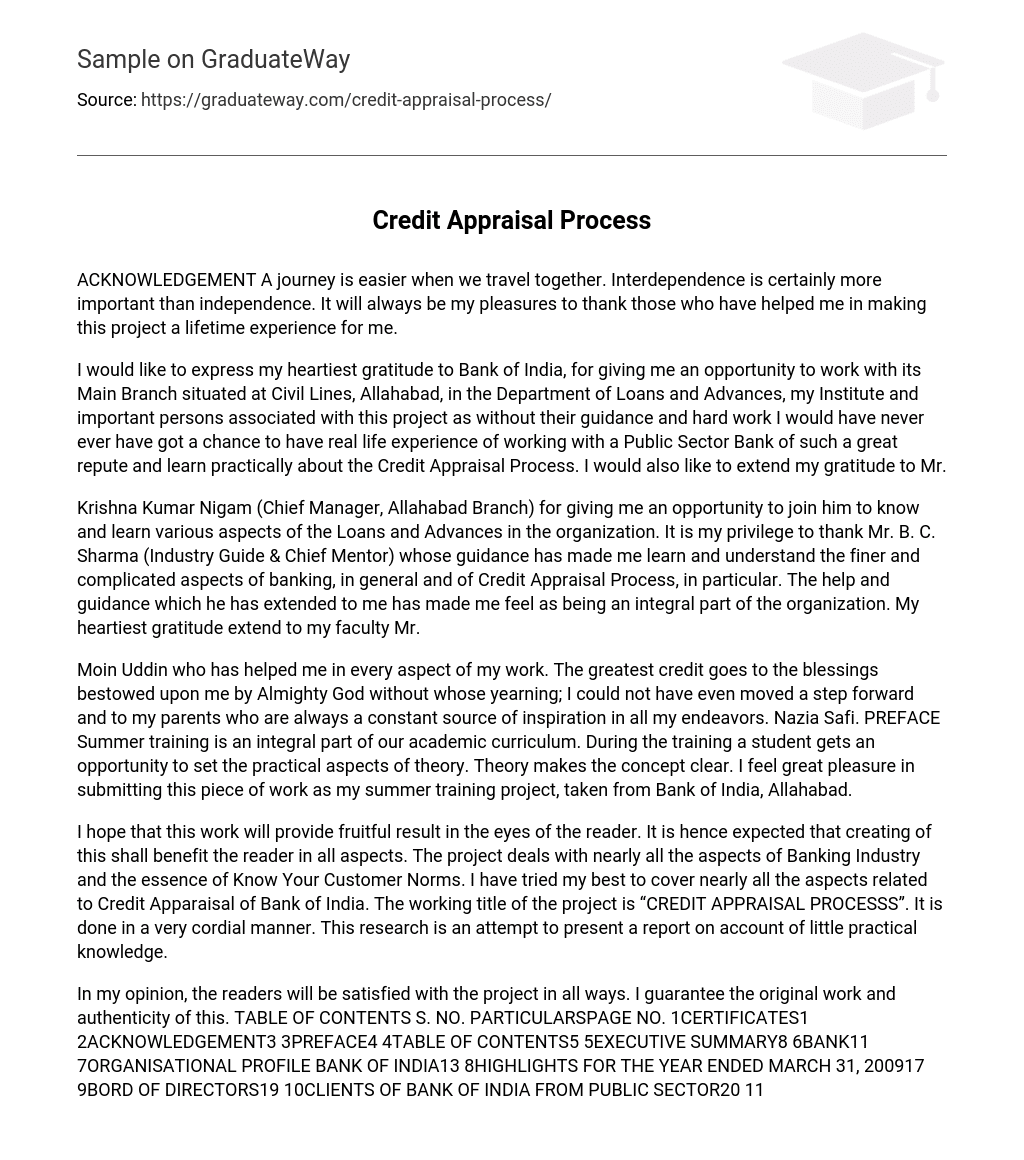The Credit Apparaisal is a holistic exercise which starts from the time a prospective borrower walks into the branch and culminates in credit delivery and monitoring with the objective of ensuring and maintaining the quality of lending and managing credit risk. The process of Credit Appraisal is multidimensional and includes- Management Appraisal, Technical Appraisal, Commercial Appraisal, Financial Appraisal and Economic Appraisal.
Management Appraisal has received lot of attention these days as it is one of the long term factors affecting the business of the concern. Technical Appraisal emphasizes on the technical feasibility of the venture and also finds out the possible economic life period of the present technology. Commercial Appraisal focuses on the commercial viability of the project . It tries to find matters regarding demand in market, the acceptance of product in market.
It also focuses on the presence of other substitutes of the product in the market. It also focuses on the multiple scope of the product. Financial Appraisal is done to find out whether the promoter is having the capacity to raise finance – both own equity and debt? What are the sources of margin? Will the business generate sufficient funds to service the debt and other stakeholders? Is the capital structure optimal? Economic Appraisal examines level of cost/ benefit and IRR (Internal Rate of Return). The scope of credit structure is incomplete without examination of credit proposal.
Credit proposal has to be examined from the point of 6 C’s viz. Character, Capacity, Capital, Condition, Collateral and Cashflow. The Credit Policy of Bank of India has undergone changes to cope with the environmental changes, tap the available opportunities, achieve their commercial objective, fulfill social obligations and adhere to mandatory directed lending norms. The credit policy consists of both fund based credit exposure and non fund based credit exposure. The credit policy is studied under – Coverage, Clientele, Marketing. The bank has over the years designed and adopted the Best Practices Code.
This in effect represents the bank’s philosophy towards effective Corporate Governance. Bank of India has specialised type of lending known as Segmented Lending in which bank has set within it specialised branches for focused lending to various segments. This includes-Commercial and Personal Finance Housing Finance Housing and Personal Finance SME Branches Overseas Branches Corporate and Banking Branches This segmented approach is expected to provide both market and customer focus for ensuring better business development, better development of expertise and better customer satisfaction.
Bank has also set exposure norms which corresponds to the quantum of finance been credited. These exposure norms are as per the RBI norms and also the bank’s specific norms. Bank also observes Selective Credit Control with respect to essential commodities like wheat, rice which would directly or indirectly defeat purpose of the directive. This policy is exclusively for essential commodities so that their prices remain same throughout the country. One of the important monitoring aspects in the credit portfolio is the periodic review of advance accounts.
The vital decision to deploy the Bank’s resources should necessarily be based upon the thorough assessment and evaluation of the needs of the borrower. For this, a proper periodical review of any account is inevitable. Bank has introduced Fair Lending Practices Code which helps the bank to provide professional, efficient, courteous, diligent and speedy services in matter of lending. The Fair Practices Code codifies the procedures to ensure clarity, transparency, timeliness and responsiveness in Bank’s relationship with the borrower customers at all stages like marketing, processing, sanctioning, monitoring and administration.
With the kind of transformation that is taking place in the banking industry and in the country, it is imperative for us to be conscious of our earnings and asset quality. Further, as profit is reward for risk bearing capacity, the spread available in case of high quality assets are thin. With the ushering in an era of liberalisation in the economy, new opportunities are available and for a Bank of our size it is important that we realise our market share through better understanding of these developments Different loan schemes are available to meet different needs of customers .
These schemes can be categorized under
- Retail loans: Includes Personal Loans, Housing Loans, Education Loans, Gold Loan Scheme, and many more.
- Agricultural loans: Includes Agriclinics and Agribusiness.
- Schemes for SME
- Schemes for Other Priority Sectors BANK
A Bank is an institution whose debt (bank deposit) is widely accepted in settlement of other people’s debt to each other. Bank is a business organization, which accepts accepts money in the form of deposits for the purpose of lending and investment. Bank repays it on demand or otherwise withdrawal by cheques, etc. bank deals with money i. e. lending and borrowing of money.
Through above process bank generates profit. Bank advances money to individual as may be required and to which individuals entrust money when not required by them for use. Commercial Banking A commercial bank is a type of financial intermediary and a type of bank. It raises funds by collecting deposits from businesses and consumers via checkable deposits, savings, deposits, and time deposits. It makes loans to businesses and consumers. It also buys corporate bonds and government bonds. Its primary liabilities are deposits and primary assets are loans and bonds. It is a business organization, which deals in money, i. e. borrowing and lending of money. In this borrowing, and lending of money it makes profit.
The Bank was private ownership and control till July 1969 when it was nationalized along with 13 other Banks. Beginning with one office in Mumbai with a paid up capital of Rs. 50 Lacs and 50 employees, the Bank has a made a rapid growth over the years and blossomed into a mighty institution with a strong national presence and sizable international operations. At present Net worth of the Bank surpasses Rs. 11100 crores. In business volume, the Bank occupies a premier position among the nationalized Banks.





